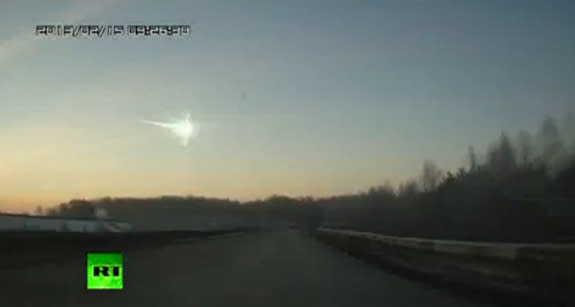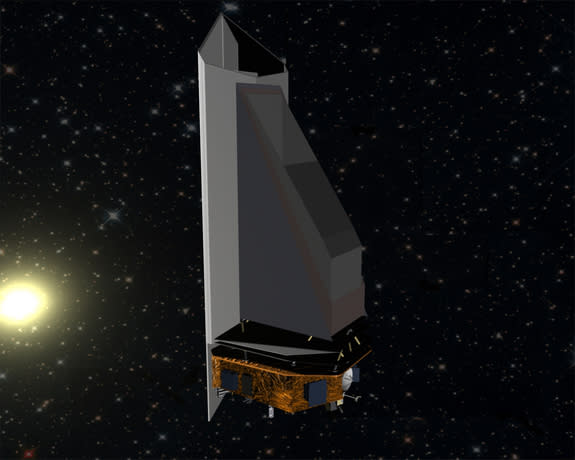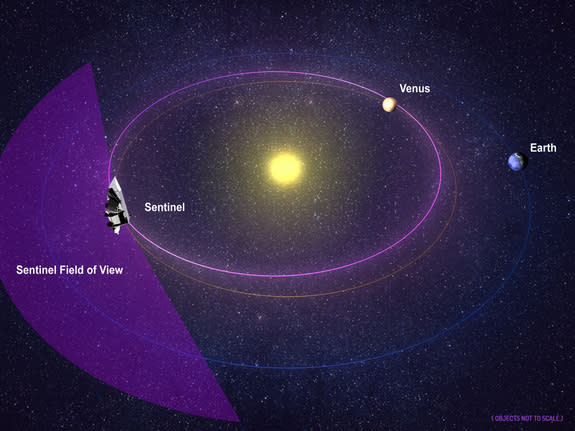Russian Meteor Fallout: What to Do Next Time?
This month's meteor detonation above the Russian city of Chelyabinsk and Earth's close shave with asteroid 2012 DA14 have kick-started conversations on lessons learned and what steps can be taken to prevent space rock impacts in the future.
One positive action item was actually in place prior to the dual asteroid events of Feb. 15: a new Memorandum of Agreement between the Air, Space, and Cyberspace Operations Directorate of the Air Force Space Command and NASA’s Science Mission Directorate.
That document, which was signed on Jan. 18 of this year, spells out specifics for the public release of meteor data from sources such as high-flying, hush-hush U.S. government space sensors.
The recent Russian meteor event occurred after completion of the newly signed agreement and data on the recent Chelyabinsk event had been released for scientific analysis, SPACE.com has been informed by NASA and the U.S. Air Force.
As a result of that agreement, NASA’s Near Earth Object (NEO) Observation Program is receiving information on bolide/fireball events "based on analysis of data collected by U.S. government sensors."[Russian Fireball: All You Need to Know (Video)]
Ripple effects
The asteroid that caused the Chelyabinsk meteor was estimated to be about 55 feet (17 meters) across with a weight of 10,000 tons. Its explosion in the atmosphere was equivalent to nearly 500,000 tons of TNT, scientists say.
Many onlookers rushed to windows to observe the streaking fireball, and as a result, more than 1,000 injuries were reported, mostly due to cuts from broken glass as shockwaves blasted through the area.
In a RAND blog, analysts Dave Baiocchi and William Welser IV took a look at the ripple effects stemming from the Russian fireball episode.
"The event over Russia illustrates some of the complex issues associated with a celestial-body event. First, these events don’t happen very frequently, so the general public is mostly unaware of what these events look like or how to react," the analysts said. [Meteor Streaks Over Russia, Explodes (Photos)]
Scorched Earth
Baiocchi and Welser said that most ongoing scientific efforts are focused on predicting impact zones or designing schemes to deflect asteroids that could pose an existential threat to Earth in the future.
"But the shattered windows and injuries in Russia show that beyond the immediate impact point there is a much wider effects radius that should be considered," the RAND researchers said.
To be sure, celestial impacts, like the Russian run-in with a meteor, are challenging to plan for because they are so uncommon, Baiocchi and Welser said.
"Proper preparations will likely require expertise and coordination among a diverse group of people and nations. The meteor over Russia, coinciding as it did with the close passage of 2012 DA14, reminds us that it’s important to consider both the direct and indirect threats posed by these objects so we are better prepared if a larger object ever threatens the planet," the analysts concluded.
Wanted: effective strategies
The Russian fireball explosion and close flyby of asteroid 2012 DA14 "should be wake-up calls that we need to get moving both on finding these smaller objects and on developing effective strategies for mitigating real threats," said William Ailor, principal engineer for the Center for Orbital and Reentry Debris Studies at The Aerospace Corporation in El Segundo, Calif.
"While we discovered 2012 DA14 before the close approach on February 15, there was not enough time to have deflected the object should it have been on an impact trajectory ... and we never saw the object that caused the Russian event before it entered the atmosphere," Ailor told SPACE.com. "We should be developing plans and capabilities now so that we have a chance to prevent even more damaging events in the future." [Asteroid 2012 DA14's Close Flyby (Photos)]
Citizen sensors
The Chelyabinsk meteor highlighted the value of "citizen sensors," noted a blog entry from the Commons Lab, a group within the Science and Technology Innovation Program of the Woodrow Wilson International Center for Scholars in Washington, D.C.
The Commons Lab draws attention to the use of everyday sensors, readily available to the public, to spot problems, gather and interpret data and act on the results.
The group points out that, while official and standardized sources were providing valuable information on the Russian skyfall, so too have decentralized citizen sensors. The number of omnipresent dashboard-mounted and handheld cameras yielded remarkable footage at the same time traditional news outlets picked up the story.
Ground perspective
"The ubiquity of these affordable recording devices allowed people in and around Chelyabinsk to document a rare and scientifically significant situation ... and some of the best footage showed up on news broadcasts around the globe," the Commons Lab blog noted.
Using all the video, scientists were able to determine that the meteor flew in at a shallow angle of 20 degrees above the horizontal, making a "grazing impact" through Earth's atmosphere.
"This event depicts the new status quo. Citizens might not be replacing traditional media, but they are certainly supporting it. The amateur footage from Chelyabinsk provides on the ground perspective that previously went unrecorded," the Commons Lab blog said. "Rapidly evolving communications, sensing, and mapping technologies have placed the extraordinary power of mass data collection and analysis into the hands of citizens, communities, governments and businesses."
Dollars for doing it right
On the technical side of the asteroid-detection issue, a number of good ideas are on the table, said Timothy Spahr, director of the Minor Planet Center at the Smithsonian Astrophysical Observatory in Cambridge, Mass.
For one, there is the Asteroid Terrestrial-impact Last Alert System (ATLAS) effort run by John Tonry in Hawaii — a warning system for objects on their final approach toward Earth. When it's up and running in 2015, ATLAS should cover the whole sky every night and provide warning for last-approach asteroids if they come from the dark sky.
Spahr told SPACE.com that the problem is that one-half of the final-approach objects come from the sunward side. "So if you are serious about getting 30-meter impactors, you need to find them when they are far from the Earth, and that requires large and expensive telescopes."
Additionally, there are two infrared spacecraft surveys that are currently proposed, Spahr said: NEOCam, a project led by researchers at NASA's Jet Propulsion Laboratory in Pasadena, Calif., and the nonprofit B612 Foundation's Sentinel space telescope, which the group aims to launch in 2018.
"Both of these would be very, very efficient discovery telescopes, and be good at finding objects down to a hundred meters or so," Spahr said. They would both find a good chunk of the smaller objects if the spaceborne scopes could be operated for long periods of time, he said.
Then there is a European Space Agency telescope being built — something like the ATLAS system, but it will use larger telescopes.
"The bottom line is that we have some good ideas (ATLAS, infrared surveys, ESA’s all-sky survey), and we just need to spend the money and roll these out. But to find the smallest objects — 30 to 50 meters in size — we are talking of the order of a billion dollars to do it right," Spahr said.
Fact-finding letter
In light of the Russian event and asteroid flyby, Congressman Jim Sensenbrenner (R-Wis.) has sent NASA chief Charles Bolden a "fact-finding letter" to better gauge the nation’s preparedness for future space rock events.
Sensenbrenner said the Russian explosion and resulting damage left many to wonder "how such an event could happen without warning." And asteroid 2012 DA14’s close flyby on the same day, while coincidental, also "raise[s] questions about our preparedness for future objects coming toward Earth."
To that end, Sensenbrenner posed a number of questions to Bolden, requesting responses by March 20:
Please explain the current arrangement for tracking cosmic objects. To what degree of certainty are the objects which pose a threat to Earth being monitored? What type of coordination is occurring on an international scale?
What shortcomings are currently present in NASA’s ability to accurately track and predict cosmic objects which may pose a threat to Earth, the moon, our satellites and other space-oriented apparatus?
How achievable are current NASA plans designed to eliminate the threats posed by cosmic objects on a collision course with Earth?
How much lead time is necessary between identifying a threat to Earth and its neutralization employing the current NASA strategies?
Eliminate the threat
"Locating and tracking these objects is clearly just the first step in preparedness," states Sensenbrenner’s letter to Bolden.
"The ability to eliminate the threat of an asteroid or meteor impacting Earth, colliding with the moon, or disrupting our space-oriented communications and scientific equipment could be vital," Sensenbrenner said.
"We would be remiss if we did not use the recent events as an opportunity to survey our current capabilities and assess how we can better use limited resources to identify potential threats," he said.
Leonard David has been reporting on the space industry for more than five decades. He is former director of research for the National Commission on Space and a past editor-in-chief of the National Space Society's Ad Astra and Space World magazines. He has written for SPACE.com since 1999.Follow SPACE.com on Twitter @Spacedotcom. We're also on Facebook & Google+.
Copyright 2013 SPACE.com, a TechMediaNetwork company. All rights reserved. This material may not be published, broadcast, rewritten or redistributed.




